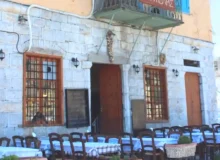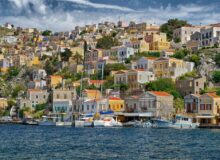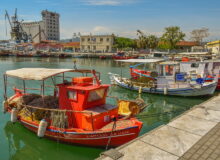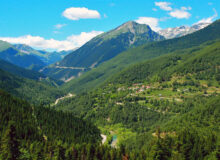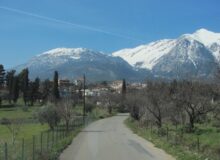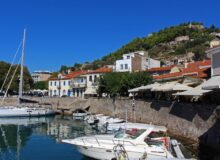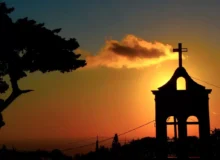The See Greece guide to the island of Delos in the Cyclades, a unique archaeological site and a popular day trip from the nearby island of Mykonos.

Nestled in the heart of the Cyclades, the small, uninhabited island of Delos is one of Greece’s most significant archaeological and mythological treasures. A UNESCO World Heritage Site since 1990, Delos was once a thriving religious, cultural, and commercial hub in antiquity. Today, it stands as an open-air museum, offering visitors a rare glimpse into the grandeur of ancient Greek civilization.
A journey to Delos is not just a trip to an island—it’s a pilgrimage into history, mythology, and the remnants of a once-powerful center of the Mediterranean world.
The Mythological Significance of Delos
According to Greek mythology, Delos was the birthplace of Apollo, the god of light, music, and prophecy, and his twin sister Artemis, goddess of the hunt. The island’s mythological importance stems from the legend of Leto, who, pregnant by Zeus, sought refuge from the vengeful Hera. Delos, a floating island at the time, was the only place that offered her sanctuary. After giving birth to Apollo and Artemis, the island was secured to the seafloor by pillars and became sacred.
This divine connection turned Delos into a major religious center. The Sanctuary of Apollo attracted pilgrims from across the Greek world, and the island flourished as a place of worship, commerce, and politics.
Exploring Delos
Today, Delos is an archaeological wonderland. Walking through its ruins feels like stepping back in time. The island’s extensive excavations reveal well-preserved remnants of temples, houses, theaters, and marketplaces, showcasing the island’s past glory.

The Terrace of the Lions
One of the most iconic landmarks on Delos is the Terrace of the Lions, a row of marble lion statues dedicated to Apollo by the people of Naxos in the 7th century BCE. Originally numbering between nine and sixteen, only five lions remain today (with replicas in place to protect the originals, now housed in the Delos Museum). These imposing statues once guarded the Sacred Lake, where Leto was said to have given birth.
The Sanctuary of Apollo
The heart of ancient Delos was the Sanctuary of Apollo, where grand temples and altars once stood. The Temple of the Delians, the Poros Temple, and the Athenian Temple are among the ruins that highlight the island’s religious significance. Nearby, the Agora of the Competaliasts (a marketplace) reveals Delos’s bustling commercial past.
The House of Dionysus & Mosaic Floors
Delos was not just a religious center—it was also a wealthy residential area. The House of Dionysus, named after its stunning mosaic of the god riding a panther, is one of many luxurious homes with intricate floor designs. Other notable villas include the House of the Dolphins and the House of the Masks, showcasing elaborate mosaics of mythological scenes and marine life.

The Ancient Theater & Mount Kynthos
The Theater of Delos, built in the 3rd century BCE, could seat up to 6,500 spectators. Though partially ruined, it offers panoramic views of the surrounding islands. Behind it lies Mount Kynthos, the island’s highest point. A climb to the summit rewards visitors with breathtaking views of the Cyclades and the remains of ancient sanctuaries dedicated to foreign gods, reflecting Delos’s cosmopolitan past.
The Sacred Lake & the Hellenistic City
The now-dry Sacred Lake was once a focal point of Delos’s religious rituals. Nearby, the ruins of the Hellenistic city include streets lined with shops, public buildings, and the impressive Stoa of Philip V. The Delos Archaeological Museum houses statues, pottery, and artifacts unearthed from the site, providing deeper insight into daily life in antiquity.
The Rise and Fall of Delos
Delos reached its peak during the Hellenistic and Roman periods, particularly after 167 BCE when Rome declared it a free port. The island became a bustling trade hub, attracting merchants from Egypt, Syria, and Italy. At its height, Delos was home to around 30,000 people, including Greeks, Romans, Jews, and Egyptians.
However, its prosperity also made it a target. In 88 BCE, Delos was sacked during the Mithridatic Wars, and again in 69 BCE by pirates. The island never fully recovered, and over time, it was gradually abandoned. By the Byzantine era, it was left in ruins, its once-great temples and houses slowly reclaimed by nature.

Visiting Delos Today
Delos is accessible by boat from nearby Mykonos, with daily excursions (weather permitting). Since the island has no permanent residents, visitors must bring water, sunscreen, and comfortable walking shoes, as exploring the ruins requires hours of walking under the sun.
Guided tours are highly recommended, as the island’s history is vast and complex. Knowledgeable guides bring the ruins to life, explaining the significance of each site. Alternatively, visitors can explore at their own pace with a detailed map.

Conclusion: A Journey Through Time
A visit to Delos is more than just sightseeing—it’s an immersive historical experience. Walking among the ruins, one can almost hear the echoes of ancient processions, the haggling of merchants, and the chants of priests honoring Apollo. The island’s serene beauty, combined with its profound historical weight, makes it a must-visit destination for anyone traveling through the Cyclades.
Delos may no longer be the thriving center it once was, but its legacy endures. As one of Greece’s most important archaeological sites, it offers an unparalleled connection to the ancient world—a sacred island frozen in time.















